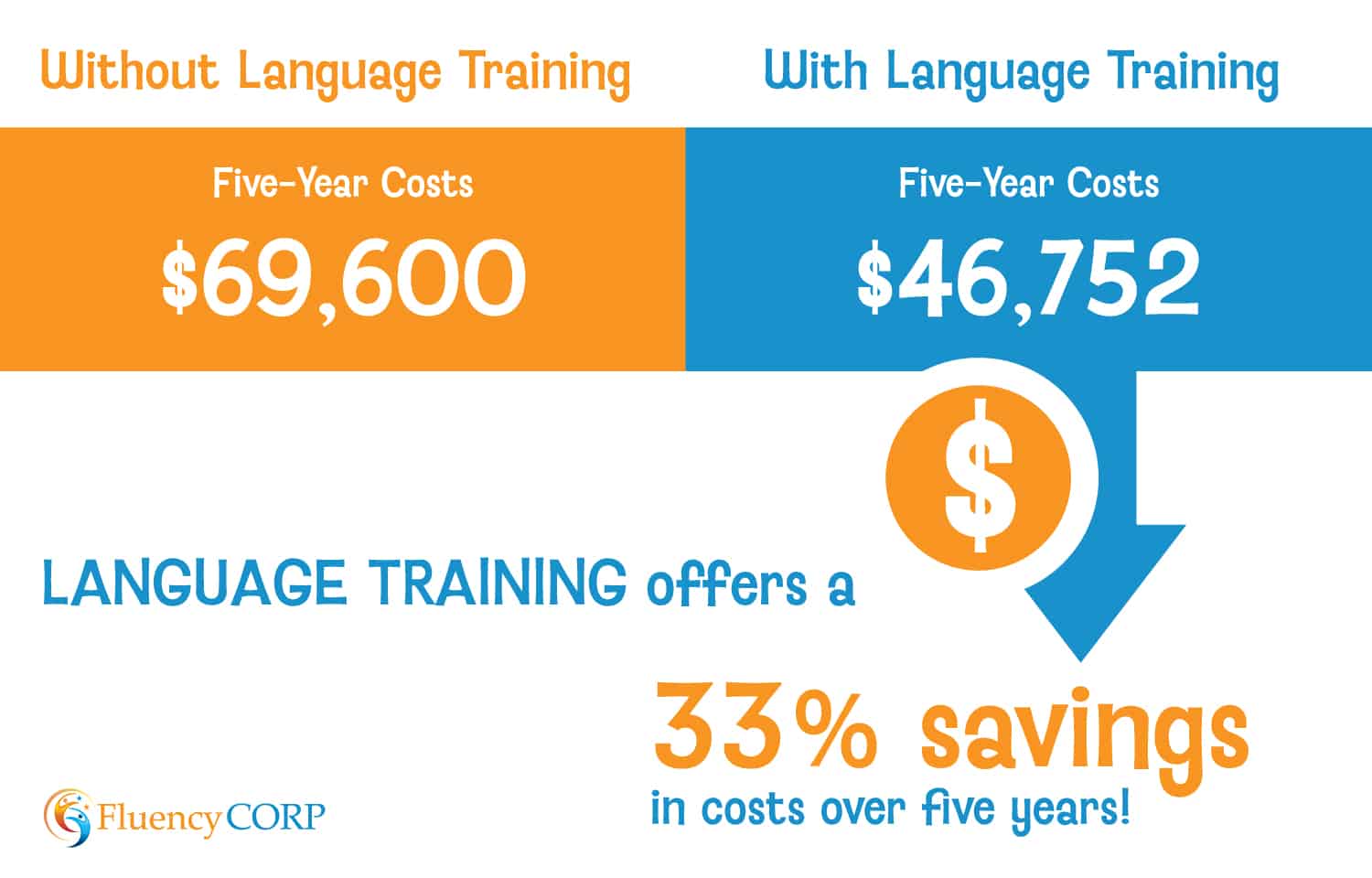
As providers of corporate language training, we hear comments and questions like these all the time:
How will providing accent reduction classes to our employees help us make more money?
Will I really help the company’s bottom line by learning Spanish?
We just don’t have time for language training.
This accountant already speaks English well enough. I don’t understand why he wants private lessons. That couldn’t possibly have any impact, right?
Basically, you can boil them all down to one key question:
Will the money we spend on corporate language training deliver a return on our investment?
We are passionate proponents of language training, but we totally understand where companies that ask this question are coming from. Their money and time are finite, their needs are many, and they have to spend wisely.
It is perfectly reasonable to ask the question: “What does corproate language training cost?” But there’s more than ample evidence that the cost of language training is worth it; an investment that pays off many times over.
Lack of Fluency Hurts the Bottom Line
We recently had a meeting with the head of HR for a multinational company that sends Japanese expats to the U.S. to work for two to four years.
We asked her how much time each employee was losing each each week due to communications breakdowns, and expected her to say two hours or so. That’s based on what our clients tell us about how much time an employee saves per week after a few months of language training.
Instead, her answer was shocking: Five hours. Five! A lack of language fluency was costing each of their employees more than a half day per week.
It’s mystifying that a company can say it doesn’t have time for language training even as it knows employees are wasting time because they don’t have the language skills they need.
To make this all a little easier to understand, we’ll consider a hypothetical situation: Let’s say your company has relocated an international employee to the U.S. The employee makes $100,000 a year. And he’s losing five hours a week due to his lack of language fluency.
When you factor in vacation, holidays and a couple of sick days per year, his hourly rate is about $58. So the price tag for those five lost hours per week is about $290.
And then there’s the time the employee’s colleagues are losing because of his communication problems. It’s likely that $290 per week is multiplied by at least 2.
Without training, the employee is likely to make some language progress, but to still have problems over the years. Here’s how that could break down:
YEAR 1
The employee loses five hours per week. If he works 48 weeks per year (after vacation, holidays, etc.), that’s $13,920, based on the hourly rate we cited above. Assuming that his communication difficulties cost other employees time as well, we can safely double that number to $27,840.
YEAR 2
The employee is now losing 3 hours per week, making the annual cost of his lack of fluency $8,352. Again, we have to figure that other employees are affected. So the total lost for year two is $16,704.
YEARs 3, 4 & 5
The employee is gaining some language skills but still has trouble connecting with and being understood by others. For these years, let’s figure a loss of 1.5 hours per week. That’s an annual cost of $4,176 for him, and $8,352 if you consider his effect on other employees. That gives us a three-year total of $25,056.
Conservatively, that Employee’s Lack of Fluency Will Cost the Company $69,600 Over Five Years!
There are also other ways your company could take a financial hit from not providing this employee language training. Without language skills, it’s harder for the employee to make meaningful contributions at work. You’re missing out on the value of his feedback, ideas and full input.
It’s also harder for the employee to feel at home in a new country and to connect with others. All of this makes it more likely that the employee’s relocation will fail and that he will move back home. Since relocation costs typically range from $72,000 to $1 million, this is a costly failure for your company.
There has to be a better way, right?
Corporate Language Training Pays Off Quickly
At Fluency Corp, we believe that a better way is to invest early in language training. Back to your original question: “What is the cost of language training?” Our classes start at $110 per week for the minimum number of hours to make steady progress. That’s $5,280 for 48 weeks of lessons per year.
The goal is that halfway through this year, your employee will be exponentially better at communicating and wasting far less time. After a year of two hours of language training per week, your employee is close to working at 100 percent (if you hired them at a B2 level, which is normal).
So let’s try that yearly breakdown again:
YEAR 1
Here are the first-year costs we’re looking at under this new scenario:
- $5,280 for a year’s worth of language instruction with a native speaker.
- $5,568 (2 hours a week x 48 weeks x the hourly rate of $58) for time “lost” to language instruction — although one could argue this isn’t really a loss.
- An average of 3 hours lost per week, plus the same amount of time lost for the employees who collaborate with him: $16,704.
That brings the Year 1 total to $27,552. We’re already saving a little money. But things are about to get even better! Not to mention, between Year 1 and Year 2 is when most relocations fail – if we add in the success of the relocation, add anywhere from $75,000 to $1 million dollars of savings.
YEAR 2
The $5,280 and $5,568 numbers stay the same. But now the employee is losing only 90 minutes per week, tops, due to language issues. We’ll continue to assume that his colleagues are losing a comparable amount of time. So the total there is $8,352. We’ve cut your company’s Year 2 losses in half compared with the other scenario.
YEAR 3
We’re still looking at $5,280 for training each year and $5,568 for the time the employee spends on the training. As he polishes his accent and further hones his ability to express ideas clearly, he’s wasting (and costing his colleagues) little to no time. Our new Year 3 total is $10,848.
YEARS 4 & 5
The employee now has strong communication skills. No more language training is needed, and no time is being wasted. Your corporate language training cost for these years? Zero.

With Language Training, our new Five-Year Total is $46,752! That compares with $69,600 in the scenario where the employee didn’t get language training, and it’s a 33 percent savings.
In other words, if you had decided that you couldn’t afford language training for the employee, you would be costing your company almost $23,000.
That’s not even taking into the account the cost of a potential failed relocation and of all the employee’s contributions that you’d be missing out on due to his lack of fluency. Language training builds collaboration, productivity and trust.
And that is simply priceless.
What Makes Corporate Language Training Affordable?
The way we keep costs down for language training is in our method. We are aiming to get employees and executives fluent as efficiently as possible. No wasted time learning irrelevant vocabulary or working with flashcards. We customize each lesson so your employees are learning what they need to be productive on the job. Emails, presentations, speaking with customers — whatever skills they need to be successful are the things we work on. Visit our FAQ’s page for more details on how language training classes work with Fluency Corp.
We offer corporate language training in cities across the globe. Cities in the U.S. like Chicago, Dallas, Seattle, and Washington D.C. have a number of international business hubs.
Choose from language classes on-site at your offices or online over Skype for employees. Spanish, English, Japanese, Mandarin, and many more languages are available. Contact us for a consultation today at getfluent@fluencycorp.com.










